What are the discerning properties that distinguish them; determining their different characteristics?
In other words, I'm trying to do a compare / contrast:
- What do they have in common?
- How are they different?
What are the discerning properties that distinguish them; determining their different characteristics?
In other words, I'm trying to do a compare / contrast:
Laser diodes use an optical resonant cavity which when injected with light above the "Lasing threshold" generates orders of magnitude more light than injected by the high Q resonance. A integrated PD detects the output so that it must be regulated to avoid out of control heat rise. A thick metal case is essential to dissipate the heat and higher power.
Natural effects of high Q emission of photons include coherence of the light with low jitter, whereas LEDs are low Q vibrations of band-gap vibrations resulting in incoherent phonon emissions of light.
Lasers are currently about 30% efficient whereas LEDs are currently up to 70% efficient.
The biggest difference? A population inversion. Second difference? Mirrors.
LED's emit light from recombination of holes and electrons across a P-N junction:


Source: Warwick
Lasers emit light from exciting a population of particles to an excited state, which then causes emission of a photon:
Mirrors also help to maintain the excitation of a population inversion. The gain of the lasing is increased with mirrors, photons are more likely to hit an excited atom causing the emission process to begin again.

Source: Olympus
So what about a laser diode? Simply a diode with mirrors (and some other atomical arrangements to keep the emission on a narrower bandwidth)
 Source: Laser diode working applications
Source: Laser diode working applications
Lazed light is different from normal light. The photons emitted from a laser have temporal and spatial coherence, meaning that they are all traveling in the same direction with the same phase, which is why it shows up so focused.
LEDs, while monochromatic (emitting a single wavelength of light) do not have temporal or spatial coherence -- the photos are not phase aligned and are not all traveling in the same direction. You can put some kind of plastic optics to route the light somewhat where you want it, but it is not lazed.
Just to add something to already good other answers:
Think Laser diode as a pure, high power non-modulated sinewave radio transmitter with nearly ideal one direction antenna, only its wavelength is small compared to radios.
Normal colored led must be (in the same analoque) considered to be a huge bunch of much lower power radio transmitters with wide beam antennas and having all slightly different frequencies and fluctuating output powers - no possiblity to use in anything that needs exactly pure sinewave and only one and well defined propagation direction is allowed.